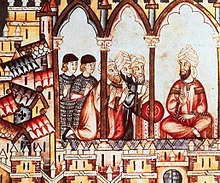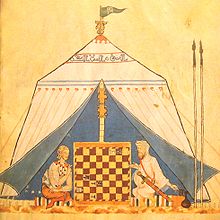ชาวมัวร์


ศัพท์ มัวร์ (อังกฤษ: Moor) เป็นชื่อที่ชาวคริสต์ในยุโรปใช้เรียกมุสลิมในอัลมัฆริบ, คาบสมุทรไอบีเรีย, ซิซิลี และมอลตาในสมัยกลาง เดิมทีชาวมัวร์คือชาวเบอร์เบอร์พื้นเพดั้งเดิมจากอัลมัฆริบ[1] ต่อมาจึงมีการนำชื่อนี้ไปใช้เรียกชาวอาหรับและชาวไอบีเรียที่แผลงเป็นอาหรับด้วย[2]
มัวร์ไม่ได้เป็นชื่อเรียกชาติพันธุ์ (ethnonym) จำเพาะของกลุ่มชนใดกลุ่มชนหนึ่ง[3] สารานุกรมบริแทนนิกา ฉบับ ค.ศ. 1911 ตั้งข้อสังเกตว่าศัพท์นี้ "ไม่มีความหมายทางชาติพันธุ์วิทยาอย่างแท้จริง"[4] ชาวยุโรปในสมัยกลางและสมัยใหม่ตอนต้นนำชื่อนี้ไปใช้เรียกกลุ่มชาติพันธุ์ต่าง ๆ อย่างหลากหลาย ไม่ว่าจะเป็นชาวอาหรับ ชาวเบอร์เบอร์แอฟริกาเหนือ หรือมุสลิมชาวยุโรป[5]
ในยุโรปยังมีการใช้ศัพท์นี้ด้วยนัยความหมายที่กว้างขึ้นในเชิงดูหมิ่น โดยใช้เรียกมุสลิมทั่วไป[6] โดยเฉพาะผู้มีเชื้อสายอาหรับหรือเบอร์เบอร์ ไม่ว่าจะอาศัยอยู่ในสเปนหรือแอฟริกาเหนือก็ตาม[7] ในสมัยอาณานิคม โปรตุเกสนำชื่อเรียก "ชาวมัวร์ศรีลังกา" และ "ชาวมัวร์อินเดีย" มาใช้ในเอเชียใต้ และมุสลิมชาวเบงกอลก็ถูกเรียกว่าเป็นชาวมัวร์ด้วย[8] ในประเทศฟิลิปปินส์ ชุมชนมุสลิมซึ่งมีอยู่ก่อนการมาถึงของสเปน ทุกวันนี้เรียกตัวเองว่า "ชาวโมโร" ซึ่งเป็นชื่อที่นักล่าอาณานิคมชาวสเปนนำมาเรียกเนื่องจากความเชื่อทางศาสนาของชุมชนนี้
ใน ค.ศ. 711 กองทัพชาวมัวร์จากแอฟริกาเหนือเริ่มการพิชิตฮิสปาเนียของอุมัยยะฮ์ คาบสมุทรไอบีเรียจึงมีชื่อเรียกในภาษาอาหรับคลาสสิกว่าอัลอันดะลุส ซึ่งในช่วงที่รุ่งเรืองที่สุดกินพื้นที่ส่วนใหญ่ของเซปทิเมเนียและสเปนกับโปรตุเกสในปัจจุบัน
ใน ค.ศ. 827 ชาวมัวร์เข้าครอบครองมาซาราที่ซิซิลี แล้วพัฒนาเป็นท่าเรือ[9] พวกเขายังพยายามรวบรวมส่วนอื่นของเกาะ ความแตกต่างทางศาสนาและวัฒนธรรมนำไปสู่ความขัดแย้งกับอาณาจักรคริสเตียนในยุโรปนานหลายศตวรรษซึ่งมีชื่อเรียกว่าเรกองกิสตา ใน ค.ศ. 1224 มุสลิมถูกเนรเทศออกจากซิซิลีไปยังนิคมที่ลูเชรา (Lucera) ซึ่งถูกชาวคริสต์ในยุโรปทำลายใน ค.ศ. 1300
การยึดกรานาดาใน ค.ศ. 1492 ถือเป็นจุดสิ้นสุดการปกครองของมุสลิมในสเปน แต่ก็มีชนกลุ่มน้อยมุสลิมอาศัยอยู่จนกระทั่งถูกขับไล่ออกไปใน ค.ศ. 1609[10]
อ้างอิง
[แก้]- ↑ Africanus, Leo (1526). The History and Description of Africa. Hakluyt Society. pp. 20 & 108. สืบค้นเมื่อ 30 August 2017.
the Mauri -- or Moors -- were the Berbers
- ↑ The Arabs called the latter Muwalladun or Muladi. Menocal (2002). Ornament of the World, p. 16; Richard A Fletcher, Moorish Spain (University of California Press, 2006), pp.1,19.
- ↑ Ross Brann, "The Moors?", Andalusia, New York University. Quote: "Andalusi Arabic sources, as opposed to later Mudéjar and Morisco sources in Aljamiado and medieval Spanish texts, neither refer to individuals as Moors nor recognize any such group, community or culture."
- ↑
 Chisholm, Hugh, บ.ก. (1911). . สารานุกรมบริตานิกา ค.ศ. 1911. Vol. 18 (11 ed.). สำนักพิมพ์มหาวิทยาลัยเคมบริดจ์. p. 812.
Chisholm, Hugh, บ.ก. (1911). . สารานุกรมบริตานิกา ค.ศ. 1911. Vol. 18 (11 ed.). สำนักพิมพ์มหาวิทยาลัยเคมบริดจ์. p. 812.
- ↑ Blackmore, Josiah (2009). Moorings: Portuguese Expansion and the Writing of Africa. U of Minnesota Press. p. xvi, 18. ISBN 978-0-8166-4832-0.
- ↑ Menocal, María Rosa (2002). Ornament of the World: How Muslims, Jews and Christians Created a Culture of Tolerance in Medieval Spain. Little, Brown, & Co. ISBN 0-316-16871-8, p. 241
- ↑ John Randall Baker (1974). Race. Oxford University Press. p. 226. ISBN 9780192129543. สืบค้นเมื่อ March 12, 2014.
In one sense the word 'Moor' means Mohammedan Berbers and Arabs of North-western Africa, with some Syrians, who conquered most of Spain in the 8th century and dominated the country for hundreds of years.
- ↑ Pieris, P.E. Ceylon and the Hollanders 1658-1796. American Ceylon Mission Press, Tellippalai Ceylon 1918
- ↑ "Assessment of the status, development and diversification of fisheries-dependent communities: Mazara del Vallo Case study report" (PDF). European Commission. 2010. p. 2. สืบค้นเมื่อ 28 September 2012.
In the year 827, Mazara was occupied by the Arabs, who made the city an important commercial harbour. That period was probably the most prosperous in the history of Mazara.
- ↑ Hillgarth, J. N. (2000). The Mirror of Spain, 1500-1700: The Formation of a Myth. University of Michigan Press. p. 67. ISBN 0-472-11092-6.
บรรณานุกรม
[แก้]- Jan R. Carew. Rape of Paradise: Columbus and the birth of racism in America. Brooklyn, NY: A&B Books, c. 1994.
- David Brion Davis, "Slavery: White, Black, Muslim, Christian." New York Review of Books, vol. 48, #11 July 5, 2001. Do not have exact pages.
- Herodotus, The Histories
- Shomark O. Y. Keita, "Genetic Haplotypes in North Africa"
- Shomarka O. Y. Keita, "Studies of ancient crania from northern Africa." American Journal of Physical Anthropology 83:35-48 1990.
- Shomarka O. Y. Keita, "Further studies of crania from ancient northern Africa: an analysis of crania from First Dynasty Egyptian tombs, using multiple discriminant functions." American Journal of Physical Anthropology 87: 345–54, 1992.
- Shomarka O. Y. Keita, "Black Athena: race, Bernal and Snowden." Arethusa 26: 295–314, 1993.
- Bernard Lewis, "The Middle East".
- Bernard Lewis. The Muslim Discovery of Europe. NY: Norton, 1982. Also an article with the same title published in Bulletin of the School of Oriental and African Studies, University of London 20(1/3): 409–16, 1957.
- Bernard Lewis, "Race and Slavery in Islam".
- Stanley Lane-Poole, assisted by E. J. W. Gibb and Arthur Gilman. The Story of Turkey. NY: Putnam, 1888.
- Stanley Lane-Poole. The Story of the Barbary Corsairs. NY: Putnam,1890.
- Stanley Lane-Poole, The History of the Moors in Spain.
- J. A. (Joel Augustus) Rogers. Nature Knows No Color Line: research into the Negro ancestry in the white race. New York: 1952.
- Ronald Segal. Islam's Black Slaves: the other Black diaspora. NY: Farrar Straus Giroux, 2001.
- Ivan Van Sertima, ed. The Golden Age of the Moor. New Brunswick: Transaction Publishers, 1992. (Journal of African civilizations, vol. 11).
- Frank Snowden. Before Color Prejudice: the ancient view of blacks. Cambridge, Massachusetts: Harvard Univ. Press, 1983.
- Frank Snowden. Blacks in antiquity: Ethiopians in the Greco-Roman experience. Cambridge, Massachusetts: Belknap Press of Harvard University Press, 1970.
- David M. Goldenberg. The Curse of Ham: race and slavery in early Judaism, Christianity, and Islam. Princeton, NJ: Princeton University Press, c2003.
- Lucotte and Mercier, various genetic studies
- Eva Borreguero. "The Moors Are Coming, the Moors Are Coming! Encounters with Muslims in Contemporary Spain." p. 417-32 in Islam and Christian-Muslim Relations, 2006, vol. 17, no. 4, pp. 417–32.
แหล่งข้อมูลอื่น
[แก้]- "The Moors" by Ross Brann, published on New York University website.
- Secret Seal: On the image of the Blackamoor in European Heraldry, a PBS article.
- Encyclopedia - Britannica Online Encyclopedia (2006)
- Khalid Amine, Moroccan Shakespeare: From Moors to Moroccans. Paper presented at an International Conference Organized by The Postgraduate School of Critical Theory and Cultural Studies, University of Nottingham, and The British Council, Morocco, 12–14 April 2001.
- Africans in Medieval & Renaissance Art: The Moor's Head เก็บถาวร 2018-07-11 ที่ เวย์แบ็กแมชชีน, Victoria and Albert Museum (n.d)
- Sean Cavazos-Kottke. Othello's Predecessors: Moors in Renaissance Popular Literature: (outline). Folger Shakespeare Library, 1998.
